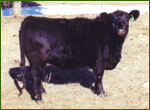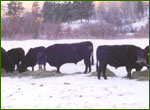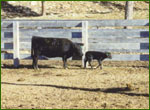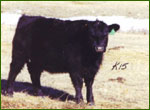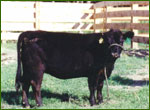


| The Lowline Breed
|
||||||||||||||||||||||||||||||||||||||||||||||||||
|
» About the Breed » History » Facts
» About the
Breed
Australian Lowlines, sometimes known as Loalas in the United States, are essentially 'miniature' Angus cattle that resulted from a 30 year research project conducted by the New South Wales State Department of Agriculture at their Agricultural Research Centre located at Trangie, Australia. The Trangie Stud's Angus herd was established to provide high quality Aberdeen-Angus cattle for New South Wales beef producers. The original registered Angus foundation stock were imported in 1929 from James D. McGregor's Glencarnock stud in Canada. The lineage of Lowine cattle can be traced to 1889 when Walter F.C. Gordon-Cuming, brother of a leading Scottish breeder, imported 43 head to Canada to form the basis of the illustrious Angus herd of the Glencarnock Farm in Brandon, Manitoba, Canada. The development of the herd was successfully guided by James D. McGregor who started in the cattle business in 1877. McGregor was attracted to the Angus for three main reasons: they were polled; they matured to market-finish quicker on grass; and they proved prolific on western Canadian ranges--all traits that are still true today. Three decades later, Australian animal scientists began to develop the Lowline breed from registered Aberdeen Angus seedstock purchased from the Glencarnock Angus herd. The original Australian importation from the Glencarnock Canadian herd included two bulls, one cow and calf, and seventeen heifers. The two bulls, "Glencarnock Revolution" and "Brave Edward Glencarnock," were from the famous "Blackcap Revolution" family. All Lowlines Are Descended From 42 Animals Approximately 12 bulls and 30 cows/heifers were acquired by Trangie during the 45 year period from 1929 to 1964. The herd then remained closed for the next 30 years. The Lowlin breed was derived from within this herd. For a twenty-year period, from 1973 to 1993, the Lowline cattle were selected solely on the basis of their yearling weight (adjusted for the age of the dam). On 30 October 1993, the New South Wales Department of Agriculture conducted a Complete Dispersal Sale. Some 22 bulls, 44 cows, 52 heifers and 29 Lowline calves were sold. These animals, together with a small number sold prior to the Dispersion, form the basis of the today's Lowline herd. The following is an extract from the Trangie Complete Dispersal
Sale Catalogue
» Facts Now you can take advantage of this opportunity to join a handful of leading breeders to supply high quality, hand selected Lowline genetics in North America. Spur Cattle Company is offering semen, embryos, and selected breeding animals. Lowline cattle are not just another novelty breed. While they are naturally quiet-tempered, easy animals to raise, they have a lot more to offer than typical fad-type breeds. Fundamentally, they are an extremely efficient range animal that produces a high quality meat product with immediate access to the existing beef infrastructure. In addition to the value-added beef products market, they represent a ground-floor opportunity to supply the initial breeder (seedstock) market. Eventually, a sizeable Lowline cow herd in America will produce market animals for a rapidly growing demand by consumers for exclusive, smaller cuts of highly marbled, lean beef. Commercial producer? Lowline cattle showed a 40% increase in retail product yield per acre off of grass... This was primarily due to higher stocking rate and a significantly higher percent retail product yield. This higher than normal retail yield has been documented repeatedly by ultra sound measurements in the US and Australia that consistently show a 30% larger rib--- eye area per hundred weight. This has translated into a boneless retail product yield of 20 to 30% more retail product per hundred weight of carcass in preliminary totally boned out product testing here in the US.
*90% calving rate. Trangie Research Center data. Regions will vary but similar averages should apply.
|

